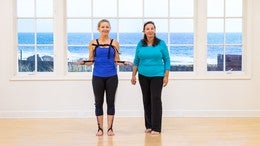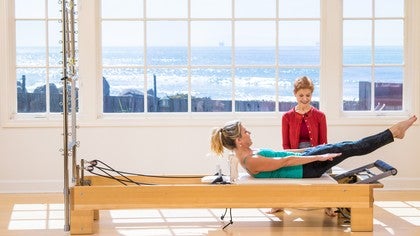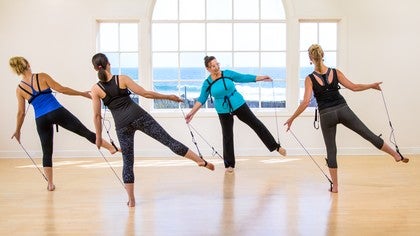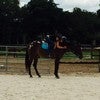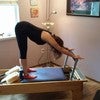Description
If you don't have a Tye4®, you can still take this class as it can be done with or without the bungees.
About This Video
Transcript
Read Full Transcript
Hi, my name is Marie [inaudible] and we're here today to learn the bone of class with the tie for the tie for is an assistance resistance, Bungee court's set up that you wear. And the Nice thing about it is you can wrap it up and put it in your suitcase whenever you go anywhere, especially if you're a dancer going on tour and you don't have much space to carry things in. Um, this, this phone up class was developed specifically for, um, a population who need increased bone density and hopefully you'll feel the very light load because of the bungees. Um, your against gravity, everything we're going to be do will be in standing. And the main thing that I'm not going to keep repeating but I want you to feel is that when you inhale, you inhale into your back ribs. So if you pull your hands forward, inhale into your back ribs expand, and as you exhale, you activate your deep abdominals from the pelvic floor up. So let's do that a few times and then we'll get started.
Inhale into your back ribs. Exhale, pull your tummy in and lift your pubic bone, pelvic floor, inhale into your back ribs. Exhale. And in doing it this way, you're actively exhaling. You're inhaling into your back ribs and really getting that diaphragm to travel down on the inhale and don't back up on the exhale. And that is really your major core muscle. And exhale.
And this time let's add a little Relevate to the inhale and exhale and inhale and exhale and inhale and exhale. One more time. Inhale, hold. Whoops. Inhale, hold and exhale down. Good Cross behind you. And now we'll repeat the same thing. The crossing of the bungees behind you gives it a little bit more resistance. So we'll put your hands through the outer loop.
Your elbows are by your side. So let's just see how it feels to extend your elbows into a low abduction and bring it back in. Yeah, you can keep it nice and low and you feel that the Bungee is now giving you a lot of support on your post, your rib cage. And then inhale, exhale as it comes in. Inhale into back ribs. Feel the bungees. Exhale as it comes in and hell and exhale. And you should also feel how supportive it is of your back. Inhale, exhale, and inhale. Exhale.
And now we'll add the relevance on the inhale. Inhale, exhale. Inhale, exhale. Inhale, exhale. Inhale. Exhale. Last one. Inhale. And let's hold the Relevate and exhale down. Good. Now put your arms down for a second. Hold onto the leg bungees and let your palms face front.
Okay, so when we hold the leg bungees, we can triangulate them and that'll give us more resistance. Or we can use the leg bungees to assist us. So if we lift your right leg up and assist you and the left leg up to assist you. So if somebody is having trouble with hip flection, this is a great way to be able to do hip flection without using their full anterior hips. Or if somebody needs a little guidance in which way to go, this is also benefit.
And now you can hold it up there and now practice pushing down and getting a little resistance, pushing down, getting a little resistance, pushing down and switch feet. Bring the other one up and pushed down and pushed down. So now you're holding it up for the hip flection, but you're giving your glutes a little resistance and relax. So now keeping your hands like that. Hold the leg bungees, and let's just do a little what it feels like to do a little bicep curl. Keep it nice and low in Hill X. Inhale, exhale, inhale, exhale.
Very nice. Inhale. Let's see how it feels with one leg. That's your right foot. Go forward. Inhale, exhale, inhale, exhale, flex the ankle. So now we've taken the weight off the foot, so we're on a single leg. Inhale, exhale. Inhale, switch in here. Keep the toe down for the first couple and exhale.
Then flex point, flex point, flex point, flex and close. Good. Back out to the side. Bungee still cross behind. And now we're just going to do a little Relevate on the way up. And this time please [inaudible] on the way down as the elbows come in. Inhale into your back ribs. Exhale close.
Inhale into your back ribs. Exhale, ple, a inhale into your back ribs. Exhale, inhale into your back ribs. Exhale, plea, AA, and now just stand with your arms out. And now we are going to challenge challenge our axial rotation stability. So we're going to turn the head to the right and come back to the center. Head to the left, come back to the center, head to the right, back to the center. Head to the left, back to the center w arms. And now we're going to do it with the inhale and the Relevate. Inhale, head to the right, back to the center. Head to the left, back to the center.
Inhale, turn. Exhale, come find your center. Inhale, turn. Exhale. Center in him. Turn. Exhale, center. Inhale, turn. Exhale, center. Last one. Inhale, turn. Exhale, center. Inhale, turn. Exhale, center. Put your arms down. Hold onto your leg. Bungee. Okay, and feel how you can triangulate it.
Now we're going to do our first cardio. All right, and we'll use the leg bungees because we can assist ourselves to do a little prancing. It's nice. We can do a little jumping and then we can do a little bouncing. Feeling the heel hit the floor so the vibration goes through the bones. And rest. Come back here to the elbows bent. And we're going to take only the right hand bungee like Bungee left arm is going to be reaching out to the side.
And as we reach out to the side and inhale, we're going to move the leg and and return. Inhale lunge. Exhale, return. Inhale, exhale, return. Now lunge. Exhale, return. Inhale, exhale, return. Last one, lunge. Exhale, return, change, arms and line. So lunge cause hell raiser and lunge. So make sure that you feel when you push yourself back that you catch yourself on your weight bearing leg. Return one more and return.
Put your arms down. Now holding onto the leg. Bungees. Turn your hands to the back and let's see what it feels like to pull your arms to the back. But don't take your pelvis back with it. Inhale, pull back. Exhale, return. Trying to feel your weight equally distributed front to back and on both feet and keep the exhale going. And sometimes you can exhale a little longer than you inhale. I like to do a four inhale and a six exhale, but that's kind of personal.
Now slide your right foot forward and hold it there and try and stay on top of your supporting leg. Don't sit into the hip, stay directly on top because you're working on a single leg stance and a single leg balance.
Feel the rotation all the way down into your feet. Inhale, exhale, center. Inhale, turn. Exhale, center. Inhale, turn. Exhale, center. Good. Now we're going to [inaudible] do a new position for our arms and strap the back. And we're going to take it around the front, put it through one loop. So your left arm will have the arm bungee and it'll pull.
And what you're going to feel is a little pull in that direction and you are resisting that pull so you're not allowing yourself to be pulled off. You're staying in center and with the hand you'll be po holding the leg. Bungee
And now we're going to turn out into a first position. Okay. And we're just going to gently swing forward, swing back, and we can bring the bungee with us initially to assist the motion and try and stay on top of your supporting leg and close plea a. Now this time we're going to bring it in as a resistance. So as the leg goes forward, the arm turns back and reverse and forward. Reverse and forward hearse and forward and reverse and forward and reverse and forward and ple a
Something that we don't get a chance to do too often. And plea a good. All right, so not slow. Let's tie it around the waist and now we'll just keep the arm bungees relaxed. We'll give them a break because we've worked a lot with our shoulders and our arms and now we're going to work a little bit more with our legs.
Of course I'm joking because we're holding the leg bungees, so we will be using our arms. All right, and let's just do a little quick movement into abduction.
Inhale, two, three, four. Exhale, two, three, four, five, six, one. Smore, two, three, four. Exhale, two, three, four, five, six, and reverse circles. Circles, circles, circles. That's it. So even though our extremities are moving quickly, the challenge is to keep your breathing continuous. So don't speed up your breathing just because you're moving your extremity quicker. And so really work on the inhalation into those back ribs and the exhalation.
Lifting up your pelvic floor, activating your deep abdominals and helping move the diaphragm back up and rest. Good. Now we'll take the legwork a little bit, turn out into a first position and points come into a second and we'll do plea, AA and down. And we'll just do a few plea A's just to warm up the hips. Really try and be centered.
And now we're going to add a challenge of rotating the head to the right and center and left and center and right and center and left and center and right and center and left and center and just relevant [inaudible]
Squeeze your shoulder blades, come back into a parallel position and hinge at the hip joints with a plea a at the knee. So feel your tailbone going backwards and return palms front. Go behind hindering from the hip joint. Nice neutral pelvis and come front and behind. Squeeze your shoulder blades here and come front and behind.
It's good for your muscles on your spine, especially the little [inaudible] muscles that keep your spine in good, stable health and fine. And now as you go back from this position, as you come forward, bring one foot off the floor, put it down as you go back. Lift the foot off the floor, put it down as you go back. Lift the foot off the floor, put it down as you go back and lift the foot off the floor. And now we're going to do a little bit of prancing or another.
And the important part about this is that you continue to breathe at the normal pace. And Bam, Bam, Bam, good. Put your heels down and bounce your heels and feel the vibration through your heel bone. Good. Arms down. All right. So now we're going to go into what I call the penguin and the star balance because balancing is very important for fall prevention and that one of the things that we really want to work on besides the vibration of the bones in this class is fall prevention by regaining better balance. And the only way to gain better balance is by balancing.
So we're going to keep our legs parallel, take the weight on one foot and assist lifting and we're going to hold this position and try and stay on top of our supporting leg for about 10 seconds. Nice balance. Keep the breathing going. You're not holding your breath and return. And now we're gonna switch sides. Bring the leg out to the side and lift and you can tilt over to the side if you like.
And really you will feel this in your lateral hip of the supporting leg, no question about it. And put the foot down and back. And now pull the arm backwards, lift the foot forward, squeeze your shoulder blade, see if you can keep your arms straight on this one. Lift your sternum to the ceiling. So we get a lot of thoracic, upper thoracic extension. This is one of the places where most people have their problems with osteoporosis because they have a rounded thoracic spine and down and the other side so that if we lift the sternum we get a little bit more extension in that upper thoracic spine and bring the arms forward.
As you bring one leg to the back, it's just a little lift. Try and keep your pelvis lifted. That's nice. Feel how your weight bearing ankle is moving side to side to keep you on your center, your base of support and switch legs and hold and return and now you're going to move your arms out as far as you can and then lift the leg and then really tilt over. Good. Really tilt over. You're giving yourself assistance and resistance at the same time and close and again how to the side lift and tilt so we get this nice star balance posture.
Keep the breath going and close. Bend your knees and straighten. All right. Now there is also [inaudible] a very nice activity that we're going to do that will coordinate our brain with our body through the use of our visual system, our eyes. So in balancing, it's really important not only to do the balance, but to change the direction of where you're looking. So we're going to start by simply holding lightly in abduction. And I'd like you to look up with your eyes. Look down with your eyes.
Look to the right with your eyes. Look to the left with your eyes. Look up relevant. Look down. Return. Look to the right. Look to the left. Look up. Relevant. A look down return. Now look right. Relevant. A return to the center. Lower look left.
Relevate return to the center. One more time. Look up relevant. Look down. Plea a look up. Relevant a look down. Please look to the right. Come back to the center. Look to the left.
Come back to the center. Look to the right, relevant way. Come back to the center. Look to the left. Relevant a, come back to the center. Look up. Relevant. A look down. Plea ae look up relevant, a look down, plea, a look to the right, relevant a, come to him, please. [inaudible] in the center. Look to the left or elevate and count together, plea a and rest. And now you're [inaudible] brain knows what your body needs to do because you just learned a lot about your balance. All right, well, thank you for watching.
I'm sure that you'll all try this with or without your bungees because these exercises are really valuable to all of you and that you've learned a lot because your bodies are smart and your brains are very interested in learning about your body. Thank you.
Anything Goes: Work with Physical Therapists, Osteopaths and More
Comments
You need to be a subscriber to post a comment.
Please Log In or Create an Account to start your free trial.
